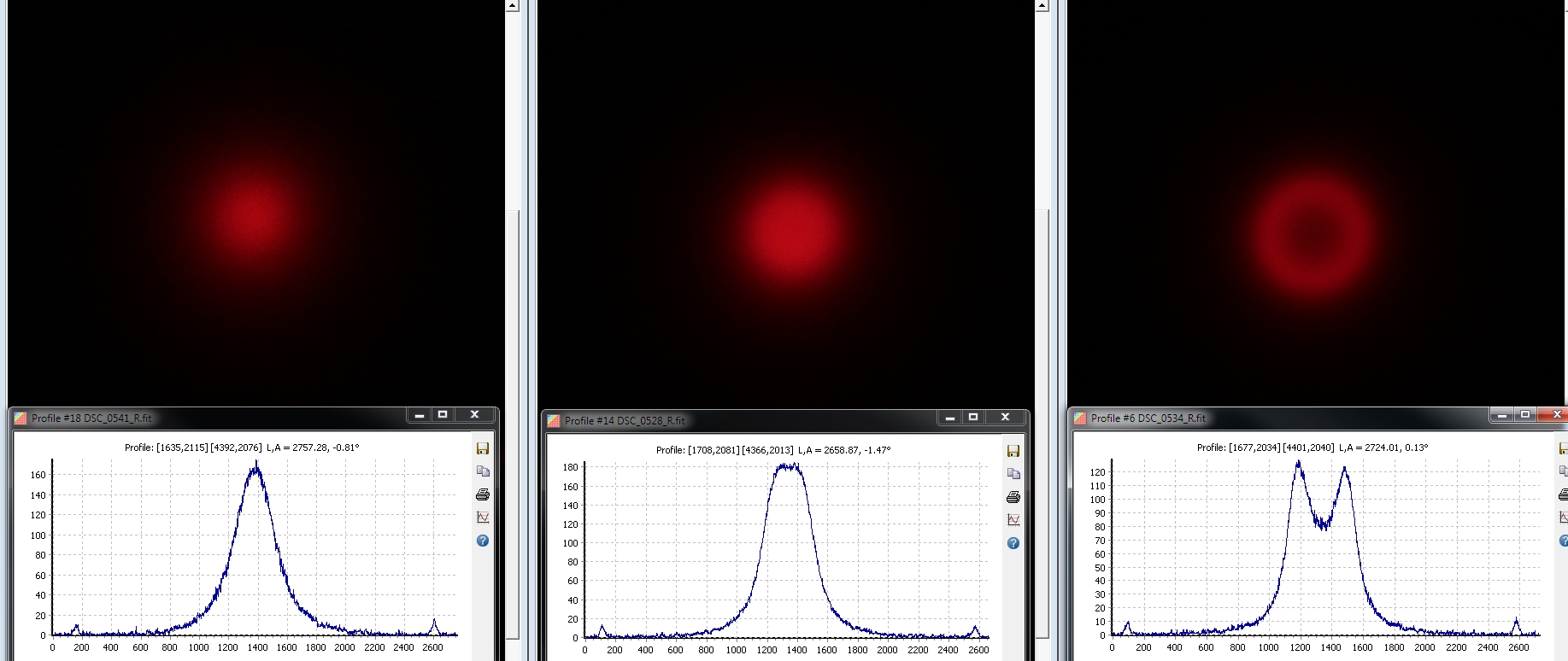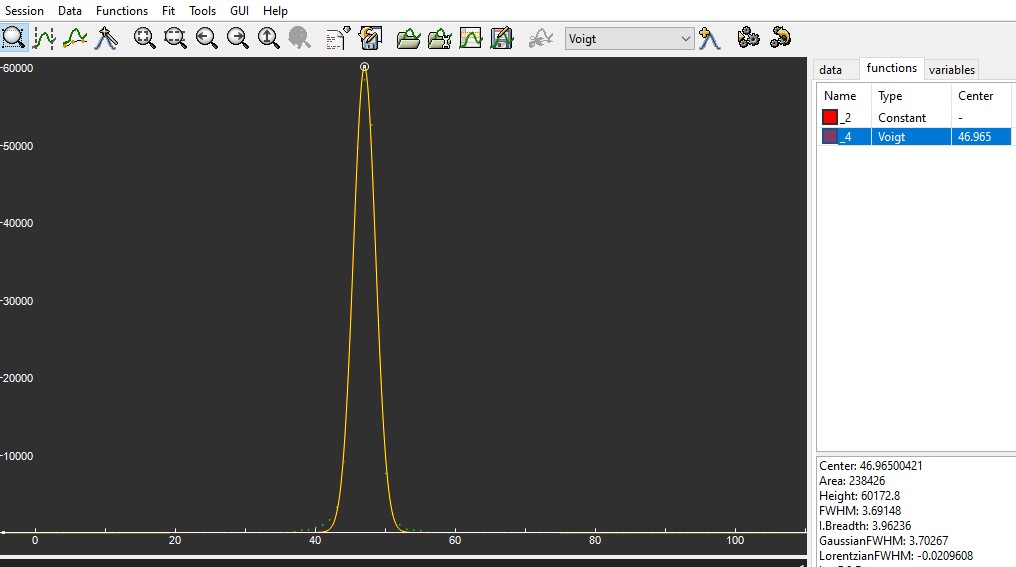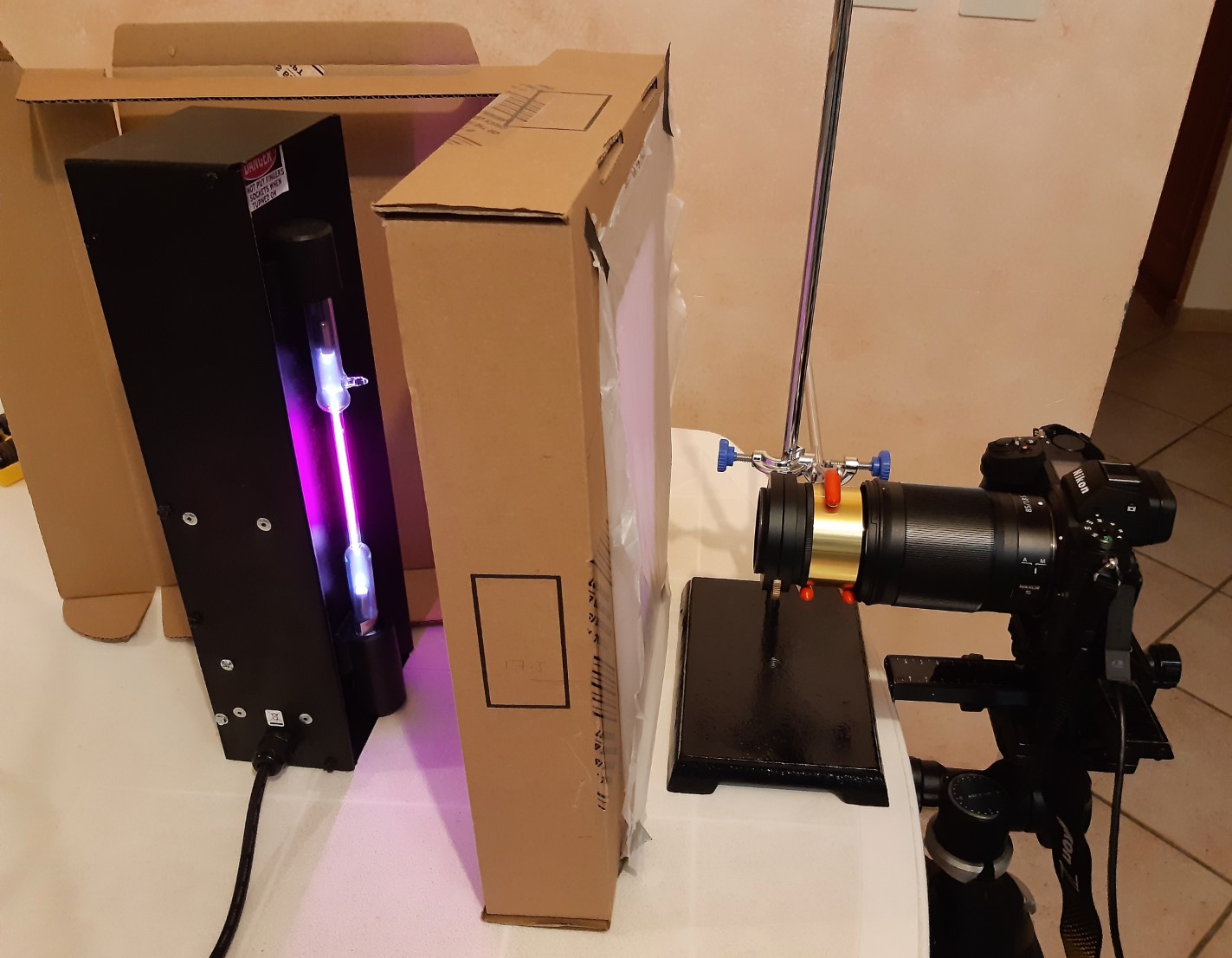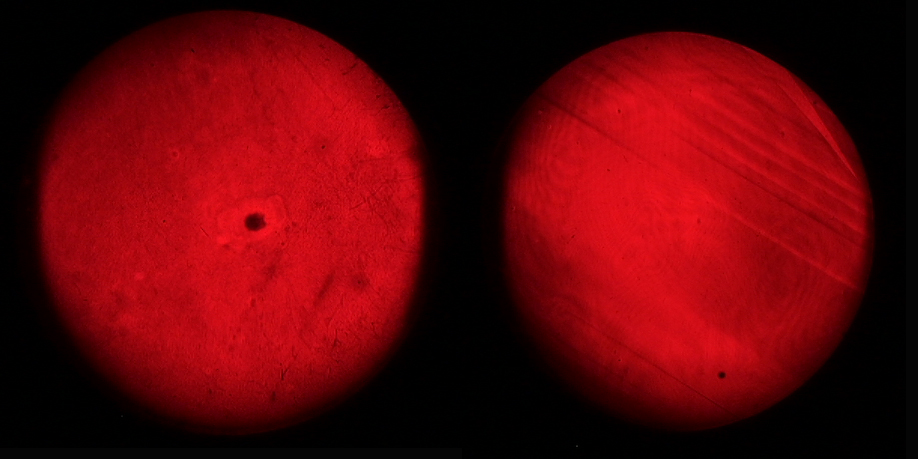- get a qualitative estimation of the etalon uniformity accross its aperture (CWL),
- get a quantitative estimation of the FWHM and FSR of the etalon.
2) Optical setup (front left to right) :
- a Ha discharge lamp from Edmund Optics is used as the light source ;
- a diffuser is placed 20 cm away from the lamp ;
- the etalon is placed next to the diffuser ;
- a camera with its lens focussed at the infinite takes an image of the interference pattern.
3) Principle of the test :
The etalon is used as an Fabry-Perot interferometer. A system of circular fringes can be observed by looking directly into the etalon or with a camera focused at infinity. The wavelength is fixed (given by the Ha lamp, whose FWHM is negligeable). Thus, the transmission profile is a function of the angle i of incident light.When used as a Fabry-Perot filter instead, the trannsmission curve of the etalon is as a function of the wavelength λ, the angle of incident light being fixed.
4) Qualitative interpretation of the fringe pattern:
(a) Qualitative information on the CWL
The test takes advantage of the following observations:
- if the CWL of the etalon at normal incidence is precisely set on the Ha line, the central fringe reduces into a central spot,
- if there is a small CWL offset, a small central dip appears in the central spot,
- as the CWL offset increases, the central fringe evolved into a ring whose diameter increases with the CWL offset.

Central interference pattern observed through a thermo-regulated mica-spaced etalon at three different settinngs of wavelengths : Ha, Ha +0.5A, Ha + 1.0 A. At +0.5A, the top of the central peak flattens. At Ha + 1.0 A, it turns into a small ring.
(b) Qualitative information on the CWL uniformity
When moving the eye (or the camera) laterally along a diameter of the aperture, the eye (or the camera) samples different areas of the etalon. The surface of the sampled area is determined by the size of the pupil (or the aperture stop of the camera). If the CWL is uniform across the surface of the etalon, the central fringe pattern (spot or ring) remains unchanged. Any change in the central fringe pattern indicates a nonuniformity of the CWL along the diameter sampled..
This test of the uniformity of the CWL is qualitative but quite sensitive and relevant.
(c) Qualitative information on the FWHM
The width of the fringes is related to the finesse of the etalon. The larger the finesse, the thinner the fringes. But without comparison to a reference etalon, it is hopeless to get any estimation of the FWHM from the visual inspection
Simulations made with webmatematica (multiple beam interference) - https://wp.optics.arizona.edu/jcwyant/mathematica/webmathematica/
François Rouvière (contributor to Solar Astronomy book) established the formulae for deriving the FSR and the FWHM of the etalon from the measurement (positions and widths) of the fringe interference pattern. A big thanks for this !
The detailed procedure and associated calculation are described here.
- The test is only qualitative (at this stage). It investigates transmission variations across the etalon aperture. These variations result from local variation of peak transmission, CWL and to a lower extent FWHM across the surface of the etalon. Indeed, if the CWL is exactly on the Ha line, any FWHM nonuniformity has no impact on the resulting image.
- For mica-spaced etalons, the transmission variations can be due to default in mica cleavage, striae, inclusions or refractive index inhomogeneities. For air-spaced etalon, transmission variations can result from thickness variation in the air gap, roughness, non unifom coating.
Optical setup (front left to right) :
- a Ha discharge lamp is used as the light source ;
- a 55 mm f/8 refractor is used as a collimator to illuminate the entire surface of the etalon. A 5 mm aperture stop placed next to the lamp limits the angular aperture of the light source to 1:88 (= 5 mm/440 mm) or 0.65°. Accordingly, the most oblique beam (0.32°) introduces a CWL shift of 0.1 Å for air-spaced etalon and 0.04 Å for mica-spaced etalon, which is quite acceptable ;
- the etalon is placed in front of the refractor lens and square to its optical axis ;
- the image of the etalon is taken by a camera (not shown in the figure) placed about 50 cm in front of the etalon. The focus of the camera is set on the etalon surface.
Note : As the light beam is collimated, the aperture of the camera determines the area of etalon sampled. For example, a 50 mm FL f/1/8 lens samples a 28 mm diameter area. This is usually large enough for mica-spaced etalons, but small compared to the free aperture of air-spaced etalons.
The test is very sensitive to non uniformities. Here are two mica-spaced etalons which look terrible in these images, but still show excellent uniformity at the telescope.
Nikon Z6 camera - 50 mm f/1.8 Nikkor lens.

Coronado SM 40 - Nikon Z6 camera - 85 mm f/1.8 S Nikkor lens - 14-bit RAW file - Red channel - 1/30 s exposure - 100 ISO.
Spectrum of the Ha lamp
By comparison, the theoritical resolution of Sol'Ex spectroscope (80 mm collimator, 125 mm imaging lens, 2400 l/mm grating) is in the range of 0.25 A at 656.2 nm, assuming that both lenses are diffraction limited (FHWM = 1.7 and 2.7 microns).




